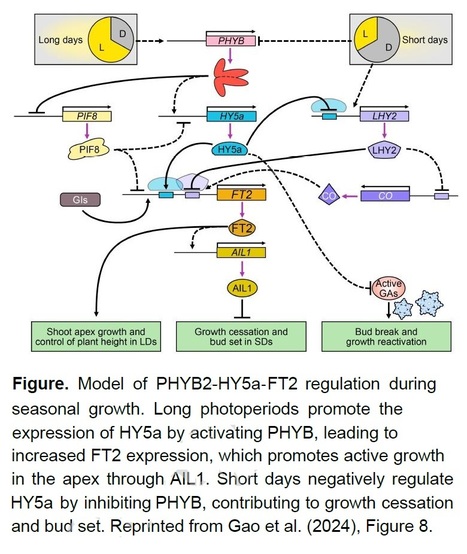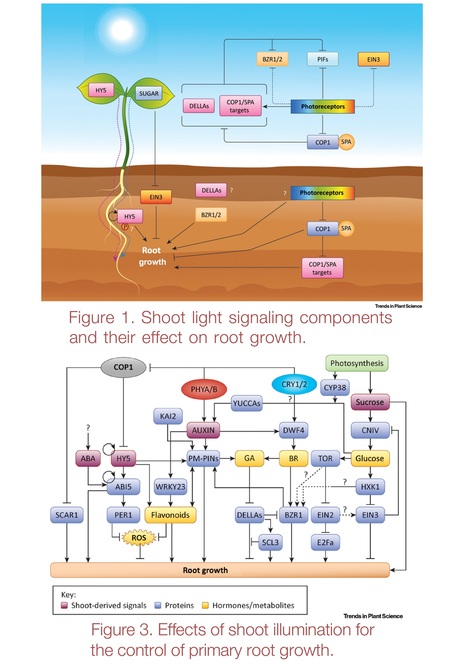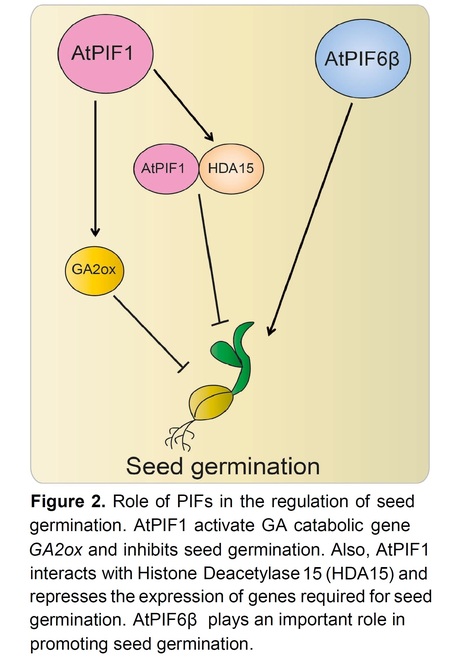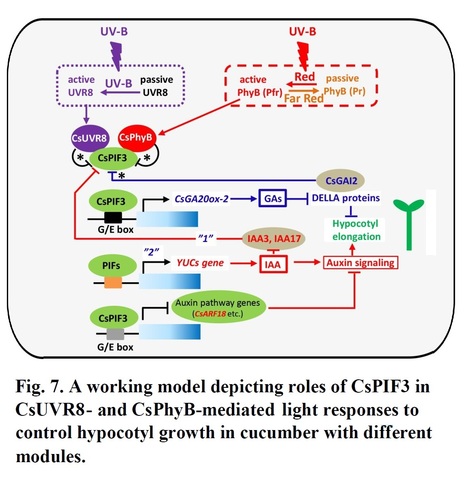Get Started for FREE
Sign up with Facebook Sign up with X
I don't have a Facebook or a X account

 Your new post is loading... Your new post is loading...
 Your new post is loading... Your new post is loading...
Authors: Nora Flynn.
The Plant Cell (2024) Excerpts: "Yongfeng Gao and colleagues (Gao et al. 2024) expose a new regulatory model for short-day-induced dormancy that involves a poplar (Populus tomentosa) ortholog of the Arabidopsis photomorphogenesis regulatory factor ELONGATED HYPOCOTYL 5 (HY5), HY5a. The model introduces poplar HY5a as a coordinator of growth cessation and bud set that promotes FLOWERING LOCUS T2 (FT2) transcription through both direct and indirect routes (Figure)." "Finally, the phenotypes of HY5a-OE and HY5a-KO plants indicated that HY5a may also be involved in bud burst. To further investigate this hypothesis, the authors compared the transcript abundances of genes related to the synthesis and breakdown of gibberellins (GA), plant hormones involved in dormancy release (Rinne et al., 2011). The activity of GA synthesis genes increased without HY5a, along with the levels of active GA. Therefore, HY5a is not only a novel regulator of short-day-induced dormancy in poplar, but also a broader controller of seasonal growth that negatively regulates GA in buds. Figure."
Julio Retamales's insight:
Commentary on the relevant article by Gao et al. ("ELONGATED HYPOCOTYL 5a modulates FLOWERING LOCUS T2 and gibberellin levels to control dormancy and bud break in poplar"), which was already posted here and is to be found at:
From
doi
Authors: Young-Joon Park, Bo Eun Nam and Chung-Mo Park. Journal of Integrative Plant Biology (2024) Abstract: "Coordinated morphogenic adaptation of growing plants is critical for their survival and propagation under fluctuating environments. Plant morphogenic responses to light and warm temperatures, termed photomorphogenesis and thermomorphogenesis, respectively, have been extensively studied in recent decades. During photomorphogenesis, plants actively reshape their growth and developmental patterns to cope with changes in light regimes. Accordingly, photomorphogenesis is closely associated with diverse growth hormonal cues. Notably, accumulating evidence indicate that the light-directed morphogenesis is profoundly affected by two recently identified phytochemicals, karrikins (KARs) and strigolactones (SLs). KARs and SLs are structurally related butenolides acting as signaling molecules during a variety of developmental steps, including seed germination. Their receptors and signaling mediators have been identified, and associated working mechanisms have been explored using gene-deficient mutants in various plant species. Of particular interests is that the KAR and SL signaling pathways play important roles in environmental responses, among which their linkages with photomorphogenesis are most comprehensively studied during seedling establishment. In this review, we focus on how the phytochemical and light signals converge on the optimization of morphogenic fitness. We also discuss molecular mechanisms underlying the signaling crosstalks with an aim of developing potential ways to improve crop productivity under climate changes."
From
doi
Authors: Hiromu Kameoka, Shota Shimazaki, Kiyoshi Mashiguchi, Bunta Watanabe, Aino Komatsu, Akiyoshi Yoda, Yohei Mizuno, Kyoichi Kodama, Masanori Okamoto, Takahito Nomura, Shinjiro Yamaguchi and Junko Kyozuka.
Current Biology (2023) Editor's view: Kameoka et al. show that DLP1 is a negative regulator of the KAI2 ligand (KL) pathway in M. polymorpha. DLP1 suppresses the KL signal upstream of the signaling pathway. DLP1 exhibits enzymatic activity toward a potential substrate. These results imply that DLP1 is a KL inactivation enzyme. Highlights: • DLP1 negatively regulates the KAI2 ligand (KL) signal in M. polymorpha • DLP1 acts upstream of the KL signaling pathway • DLP1 retains enzymatic activities • DLP1 homologs in A. thaliana do not play a major role in the KL pathway Abstract: "Karrikins are smoke-derived butenolides that induce seed germination and photomorphogenesis in a wide range of plants.1,2,3 KARRIKIN INSENSITIVE2 (KAI2), a paralog of a strigolactone receptor, perceives karrikins or their metabolized products in Arabidopsis thaliana.4,5,6,7 Furthermore, KAI2 is thought to perceive an unidentified plant hormone, called KAI2 ligand (KL).8,9 KL signal is transduced via the interaction between KAI2, MORE AXILLARY GROWTH2 (MAX2), and SUPPRESSOR of MORE AXILLARY GROWTH2 1 LIKE family proteins (SMXLs), followed by the degradation of SMXLs.4,7,10,11,12,13,14 This signaling pathway is conserved both in A. thaliana and the bryophyte Marchantia polymorpha.14 Although the KL signaling pathway is well characterized, the KL metabolism pathways remain poorly understood. Here, we show that DIENELACTONE HYDROLASE LIKE PROTEIN1 (DLP1) is a negative regulator of the KL pathway in M. polymorpha. The KL signal induces DLP1 expression. DLP1 overexpression lines phenocopied the Mpkai2a and Mpmax2 mutants, while dlp1 mutants phenocopied the Mpsmxl mutants. Mutations in the KL signaling genes largely suppressed these phenotypes, indicating that DLP1 acts upstream of the KL signaling pathway, although DLP1 also has KL pathway-independent functions. DLP1 exhibited enzymatic activity toward a potential substrate, suggesting the possibility that DLP1 works through KL inactivation. Investigation of DLP1 homologs in A. thaliana revealed that they do not play a major role in the KL pathway, suggesting different mechanisms for the KL signal regulation. Our findings provide new insights into the regulation of the KL signal in M. polymorpha and the evolution of the KL pathway in land plants."
Authors: Han-Wei Jiang, Kai-Chun Peng, Ting-Yu Hsu, Yen-Chang Chiou and Hsu-Liang Hsieh. PLoS Genetics (2023) Abstract: "Integration of light and phytohormones is essential for plant growth and development. FAR-RED INSENSITIVE 219 (FIN219)/JASMONATE RESISTANT 1 (JAR1) participates in phytochrome A (phyA)-mediated far-red (FR) light signaling in Arabidopsis and is a jasmonate (JA)-conjugating enzyme for the generation of an active JA-isoleucine. Accumulating evidence indicates that FR and JA signaling integrate with each other. However, the molecular mechanisms underlying their interaction remain largely unknown. Here, the phyA mutant was hypersensitive to JA. The double mutant fin219-2phyA-211 showed a synergistic effect on seedling development under FR light. Further evidence revealed that FIN219 and phyA antagonized with each other in a mutually functional demand to modulate hypocotyl elongation and expression of light- and JA-responsive genes. Moreover, FIN219 interacted with phyA under prolonged FR light, and MeJA could enhance their interaction with CONSTITUTIVE PHOTOMORPHOGENIC 1 (COP1) in the dark and FR light. FIN219 and phyA interaction occurred mainly in the cytoplasm, and they regulated their mutual subcellular localization under FR light. Surprisingly, the fin219-2 mutant abolished the formation of phyA nuclear bodies under FR light. Overall, these data identified a vital mechanism of phyA–FIN219–COP1 association in response to FR light, and MeJA may allow the photoactivated phyA to trigger photomorphogenic responses."
Authors: Cássia Fernanda Stafen, Jürgen Kleine-Vehn and Felipe dos Santos Maraschin.
Trends in Plant Science (2022) Highlights The early seedling root growth is largely responsive to shoot illumination and the signaling processes leading to photomorphogenesis are functional both in shoots and roots. Developmental and nutritional tradeoffs between shoots and roots are central to organ growth. Tissue-specific responses play a prominent role in light responsive root growth. Long-distance systemic signals coordinate the seedling growth responses to light. Abstract: "A germinating seedling incorporates environmental signals such as light into developmental outputs. Light is not only a source of energy, but also a central coordinative signal in plants. Traditionally, most research focuses on aboveground organs’ response to light; therefore, our understanding of photomorphogenesis in roots is relatively scarce. However, root development underground is highly responsive to light signals from the shoot and understanding these signaling mechanisms will give a better insight into early seedling development. Here, we review the central light signaling hubs and their role in root growth promotion of Arabidopsis thaliana seedlings."
Authors: Jiachen Zhao, Guangqiong Yang, Lu Jiang, Shilong Zhang, Langxi Miao, Peng Xu, Huiru Chen, Li Chen, Zhilei Mao, Tongtong Guo, Shuang Kou, Hong-Quan Yang and Wenxiu Wang. Frontiers in Plant Science (2022) Abstract: "Phytochromes A and B (phyA and phyB) are the far-red and red lights photoreceptors mediating many light responses in Arabidopsis thaliana. Brassinosteroid (BR) is a pivotal phytohormone regulating a variety of plant developmental processes including photomorphogenesis. It is known that phyB interacts with BES1 to inhibit its DNA-binding activity and repress BR signaling. Here, we show that far-red and red lights modulate BR signaling through phyA and phyB regulation of the stability of BIN2, a glycogen synthase kinase 3 (GSK3)-like kinase that phosphorylates BES1/BZR1 to inhibit BR signaling. The BIN2 gain-of-function mutant bin2-1 displays an enhanced photomorphogenic phenotype in both far-red and red lights. phyA-enhanced accumulation of BIN2 promotes the phosphorylation of BES1 in far-red light. BIN2 acts genetically downstream from PHYA to regulate photomorphogenesis under far-red light. Both phyA and phyB interact directly with BIN2, which may promote the interaction of BIN2 with BES1 and induce the phosphorylation of BES1. Our results suggest that far-red and red lights inhibit BR signaling through phyA and phyB stabilization of BIN2 and promotion of BES1 phosphorylation, which defines a new layer of the regulatory mechanism that allows plants to coordinate light and BR signaling pathways to optimize photomorphogenesis."
Authors: Hang Zhao and Ying Bao.
Plant Science (2021) Highlights: • Plants have evolved elaborate sensory systems to perceive fluctuations in temperature and light. • Photosensory systems can be delivered via PIF4 to optimize plant architecture and physiology. • PIF4 acts as a crucial regulator of plant thermomorphogenesis. • PIF4 integrates environmental temperature and light cues to regulate plant growth. Abstract: "Plants are sessile and lack behavourial responses to avoid extreme environmental changes linked to annual seasons. For survival, they have evolved elaborate sensory systems coordinating their architecture and physiology with fluctuating diurnal and seasonal temperatures. PHYTOCHROME-INTERACTING FACTOR 4 (PIF4) was initially identified as a key component of the Arabidopsis thaliana phytochrome signalling pathway. It was then identified as playing a central role in promoting plant hypocotyl growth via the activation of auxin synthesis and signalling-related genes. Recent studies expanded its known regulatory functions to thermomorphogenesis and defined PIF4 as a central molecular hub for the integration of environmental light and temperature cues. The present review comprehensively summarizes recent progress in our understanding of PIF4 function in Arabidopsis thaliana, including PIF4-mediated photomorphogenesis and thermomorphogenesis, and the contribution of PIF4 to plant growth via the integration of environmental light and temperature cues. Remaining questions and possible directions for future research on PIF4 are also discussed." |
Authors: Junling Huai, Nan Gao, Yuanyuan Yao, Yanxin Du, Qiang Guo and Rongcheng Lin. Plant Physiology (2024) One-sentence summary: A jasmonic acid signaling component regulates Arabidopsis photo- and thermo-morphogenesis by repressing PHYTOCHROME-INTERACTING FACTOR4. Abstract: "Light and temperature are two major environmental factors that affect growth and development of plants during their life cycle. Plants have evolved complex mechanisms to adapt to varying external environments. Here, we show that JASMONATE ZIM-domain protein 3 (JAZ3), a jasmonic acid signaling component, acts as a factor to integrate light and temperature in regulating seedling morphogenesis. JAZ3 overexpression transgenic lines display short hypocotyls under red, far-red, and blue light and warm temperature (28 °C) conditions compared to the wild type in Arabidopsis (Arabidopsis thaliana). We show that JAZ3 interacts with the transcription factor PHYTOCHROME-INTERACTING FACTOR4 (PIF4). Interestingly, JAZ3 spontaneously undergoes liquid-liquid phase separation (LLPS) in vitro and in vivo and promotes LLPS formation of PIF4. Moreover, transcriptomic analyses indicate that JAZ3 regulates the expression of genes involved in many biological processes, such as response to auxin, auxin-activated signaling pathway, regulation of growth, and response to red light. Finally, JAZ3 inhibits the transcriptional activation activity and binding ability of PIF4. Collectively, our study reveals a function and molecular mechanism of JAZ3 in regulating plant growth in response to environmental light and temperature."
Julio Retamales's insight:
Good paper!
From
doi
Authors: Yan Yan, Haofei Luo, Yuwei Qin, Tingting Yan, Jinbu Jia, Yifeng Hou, Zhijian Liu, Jixian Zhai, Yanping Long, Xian Deng and Xiaofeng Cao.
PNAS (2024) Significance: Photomorphogenesis is a pivotal stage in early seedling growth that begins when the shoot first emerges from the soil and is exposed to light. Here, we investigated the role of post-transcriptional splicing (PTS) in this developmental stage. By applying Nanopore sequencing of full-length nascent RNA, we found that thousands of genes undergo light-responsive PTS. We used snRNA-seq to characterize seedlings under continuous darkness, or after 1 or 6 h of light exposure, revealing that transcripts showing light-responsive PTS are specifically enriched in mesophyll cells. We identified the splicing factor AtPRMT5 and the E3 ubiquitin ligase COP1 as key regulators of these light-responsive PTS events. These findings uncover how cell type–specific regulation of PTS is essential for the onset of photomorphogenesis. Abstract: "Light plays a central role in plant growth and development, providing an energy source and governing various aspects of plant morphology. Previous study showed that many polyadenylated full-length RNA molecules within the nucleus contain unspliced introns (post-transcriptionally spliced introns, PTS introns), which may play a role in rapidly responding to changes in environmental signals. However, the mechanism underlying post-transcriptional regulation during initial light exposure of young, etiolated seedlings remains elusive. In this study, we used FLEP-seq2, a Nanopore-based sequencing technique, to analyze nuclear RNAs in Arabidopsis (Arabidopsis thaliana) seedlings under different light conditions and found numerous light-responsive PTS introns. We also used single-nucleus RNA sequencing (snRNA-seq) to profile transcripts in single nucleus and investigate the distribution of light-responsive PTS introns across distinct cell types. We established that light-induced PTS introns are predominant in mesophyll cells during seedling de-etiolation following exposure of etiolated seedlings to light. We further demonstrated the involvement of the splicing-related factor A. thaliana PROTEIN ARGININE METHYLTRANSFERASE 5 (AtPRMT5), working in concert with the E3 ubiquitin ligase CONSTITUTIVE PHOTOMORPHOGENIC 1 (COP1), a critical repressor of light signaling pathways. We showed that these two proteins orchestrate light-induced PTS events in mesophyll cells and facilitate chloroplast development, photosynthesis, and morphogenesis in response to ever-changing light conditions. These findings provide crucial insights into the intricate mechanisms underlying plant acclimation to light at the cell-type level."
Authors: Jayne Griffiths, Annalisa Rizza, Bijun Tang, Wolf B. Frommer and Alexander M. Jones. bioRxiv (2023) Abstract: "The phytohormone gibberellin (GA) is critical for environmentally sensitive plant development including germination, skotomorphogenesis and flowering. The FRET biosensor GIBBERELLIN PERCEPTION SENSOR1, which permits single-cell GA measurements in vivo, was previously used to observe a GA gradient correlated with cell length in dark-grown but not light-grown hypocotyls. We sought to understand how light signalling integrates into cellular GA regulation. Here we show how the E3 ligase COP1 and transcription factor HY5 play central roles in directing cellular GA distribution in skoto- and photomorphogenic hypocotyls, respectively. We demonstrate that the expression pattern of biosynthetic enzyme GA20ox1 is the key determinant of the GA gradient in dark-grown hypocotyls and is a target of COP1 signalling. We engineered a second generation GPS2 biosensor with improved orthogonality and reversibility to show the cellular pattern of GA depletion during the transition to growth in the light. This GA depletion partly explains the resetting of hypocotyl growth dynamics during photomorphogenesis. Achieving cell-level resolution has revealed how GA distributions link environmental conditions with morphology and morphological plasticity and the GPS2 biosensor is an ideal tool for GA studies in further conditions, organs and plant species."
Julio Retamales's insight:
Breakthrough!
Authors: Aishwarye Sharma, Harsha Samtani, Karishma Sahu, Arun Kumar Sharma, Jitendra Paul Khurana and Paramjit Khurana.
International Journal of Biological Macromolecules (2023) Abstract: "Transcription factors play important roles in governing plant responses upon changes in their ambient conditions. Any fluctuation in the supply of critical requirements for plants, such as optimum light, temperature, and water leads to the reprogramming of gene-signaling pathways. At the same time, plants also evaluate and shift their metabolism according to the various stages of development. Phytochrome-Interacting Factors are one of the most important classes of transcription factors that regulate both developmental and external stimuli-based growth of plants. This review focuses on the identification of PIFs in various organisms, regulation of PIFs by various proteins, functions of PIFs of Arabidopsis in diverse developmental pathways such as seed germination, photomorphogenesis, flowering, senescence, seed and fruit development, and external stimuli-induced plant responses such as shade avoidance response, thermomorphogenesis, and various abiotic stress responses. Recent advances related to the functional characterization of PIFs of crops such as rice, maize, and tomato have also been incorporated in this review, to ascertain the potential of PIFs as key regulators to enhance the agronomic traits of these crops. Thus, an attempt has been made to provide a holistic view of the function of PIFs in various processes in plants.
Julio Retamales's insight:
Comprehensive review.
Authors: Jianyu Zhao, Kailiang Bo, Yupeng Pan, Yuhong Li, Daoliang Yu, Chuang Li, Jiang Chang, Shuang Wu, Zhongyi Wang, Xiaolan Zhang, Xingfang Gu and Yiqun Weng. Journal of Experimental Botany (2023) Highlight: Cucumber phytochrome interacting factor 3 (CsPIF3) physically interacts with both CsPhyB and CsUVR8 connecting the red/far-red and UVB light response pathways for hypocotyl growth. Abstract: "In Arabidopsis, the photoreceptors phytochrome B- (PhyB) and UVB resistance 8- (UVR8) mediated light responses play a major role in regulating photomorphogenic hypocotyl growth, but how they crosstalk to coordinate this process is not well understood. Here we report map-based cloning and functional characterization of a UVB-insensitive, long-hypocotyl mutant, lh1, and a wild-type-like lh2 mutant in cucumber, Cucumis sativus, which encodes a defective CsPhyB and a key gibberellic acid (GA) biosynthesis enzyme CsGA20ox-2, respectively. The lh2 mutation was epistatic to lh1 and partly suppressed long-hypocotyl phenotype in the lhl1lh2 double mutant. We identified phytochrome interacting factor (PIF) CsPIF3 that played a critical role in integrating the red/far-red and UVB light responses for hypocotyl growth. We show that two modules, CsPhyB-CsPIF3-CsGA20ox-2 (GA oxidase2)-DELLA and CsPIF3-CsARF18 (auxin response factor 18) mediate CsPhyB-regulated hypocotyl elongation through GA and auxin pathways, respectively, in which CsPIF3 binds to the G-/E-box motifs in the promoters of CsGA20ox-2 and CsARF18 to regulate their expression. We also identified a new physical interaction between CsPIF3 and CsUVR8 mediating CsPhyB-dependent, UVB-induced hypocotyl growth inhibition. Our work suggests that hypocotyl growth in cucumber involves a complex interplay of multiple photoreceptor- and phytohormone-mediated signaling pathways that show both conservation with and divergence from those in Arabidopsis."
Authors: Jae Young Kim, Young-Joon Park, June-Hee Lee and Chung-Mo Park.
Plant and Cell Physiology (2022) Abstract: "Morphogenic adaptation of young seedlings to light environments is a critical developmental process that ensures plant survival and propagation, as they emerge from the soil. Photomorphogenic responses are facilitated by a network of light and growth hormonal signals, such as auxin and gibberellic acid (GA). Karrikins (KARs), a group of butenolide compounds that is produced from burning plant materials in wildfires, are known to stimulate seed germination in fire-prone plant species. Notably, recent studies support that they also regulate seedling growth, while underlying molecular mechanisms have been unexplored yet. Here, we demonstrate that SUPPRESSOR OF MAX2 1 (SMAX1), a negative regulator of KAR signaling, integrates light and KAR signals into GA-DELLA pathways that regulate hypocotyl growth during seedling establishment. We found that SMAX1 facilitates degradation of DELLA proteins in the hypocotyls. Interestingly, light induces accumulation of SMAX1 proteins, and SMAX1-mediated degradation of DELLA is elevated in seedling establishment during the dark-to-light transition. Our observations indicate that SMAX1-mediated integration of light and KAR signals into GA pathways elaborately modulates seedling establishment.
From
doi
Authors: Maxime Hamon-Josse, Jose Antonio Villaecija Aguilar, Karin Ljung, Ottoline Leyser, Caroline Gutjahr and Tom Bennett.
New Phytologist (2022) Abstract: "Photomorphogenic remodelling of seedling growth is a key developmental transition in the plant life cycle. The α/β-hydrolase signalling protein KARRIKIN-INSENSITIVE2 (KAI2), a close homologue of the strigolactone receptor DWARF14 (D14), is involved in this process, but it is unclear how the effects of KAI2 on development are mediated. Here, using a combination of physiological, pharmacological, genetic and imaging approaches in Arabidopsis thaliana (Heynh.) we show that kai2 phenotypes arise because of a failure to downregulate auxin transport from the seedling shoot apex towards the root system, rather than a failure to respond to light per se. We demonstrate that KAI2 controls the light-induced remodelling of the PIN-mediated auxin transport system in seedlings, promoting a reduction in PIN7 abundance in older tissues, and an increase of PIN1/PIN2 abundance in the root meristem. We show that removing PIN3, PIN4 and PIN7 from kai2 mutants, or pharmacological inhibition of auxin transport and synthesis, is sufficient to suppress most kai2 seedling phenotypes. We conclude that KAI2 regulates seedling morphogenesis by its effects on the auxin transport system. We propose that KAI2 is not required for the light-mediated changes in PIN gene expression but is required for the appropriate changes in PIN protein abundance within cells."
Julio Retamales's insight:
This article was already posted here when published as a preprint.
|























